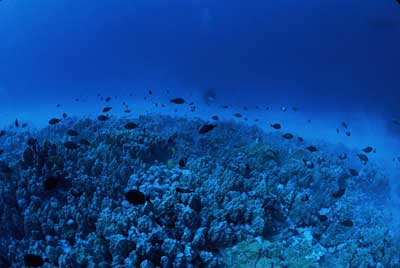|
You
are here: /main/for
teachers /pollutants on coral
For
Teachers
Pollutants
on Coral

Coral
reef . Photo by Jim Maragos, USFWS.
Grades:
3 - 6
Focus
Question: What effect do indirect pollutants like carbon
dioxide have on the reef ecosystem?
Lesson at a Glance: Students will perform experiments
to examine what effect acid has on coral..
Key
Concepts: Coral is the basic building block for reefs.
The individual coral polyps are small and soft bodied with
a hard external skeleton surrounding it. These small animals
live in large colonies building off the skeletons of other
polyps. While the coral is strong enough to be used as building
blocks for houses it is very susceptible to some environmental
factors such as acid rain.
Objectives:
Students
will be able to:
- Describe
the life cycle of a coral.
- Give
examples of how coral is used by people and animal
- Identify
some of the factors that destroy coral reefs
Time:
One class period.
Materials: Samples of coral, not collected from a living
reef.(in Hawaii - contact the Dept.
of Land and Natural Resources, Division of Aquatic Resources
for coral collection regulations and permits), diagram of
a coral polyp and its life cycle, magnifying glass or microscope,
pipette, vinegar.
Teacher
Background: Coral reefs have existed for over 500 million
years. Most reefs are in the tropics, the area between the
Tropic of Cancer and the Tropic of Capricorn. These 'rain
forests of the sea', contain approximately 25% of the ocean's
species.
Coral
begins as an individual polyp the size of a pea. The soft-bodied
polyp builds a cup-shaped skeleton made of calcium carbonate
around its soft body. They reproduce by creating new branches
or sprouts. While the individual animals are small a colony
can be huge. The Great Barrier Reef in Australia is the only
living structure that can be seen from space.
These
structures made of living and dead skeletons are strong enough
to withhold currents, salt water and temperature changes to
name a few. Humans have used blocks made of coral for construction
for many years. The Chamberlain House and Kawaiahao Church
in Honolulu are examples of coral block construction from
the mid-19th century. More recently coral has been used to
help build up runways in the Northwestern Hawaiian islands.
The
basic structure of the reef is strong but it is not invincible.
The reefs reflect the environment around it. If the surrounding
area is healthy the reef will often be healthy as well. Acids
from our car exhaust eat away at our fragile reefs along with
other pollutants. Reefs are especially vulnerable because
they take so long to regenerate.
Procedure
and Preparation:
- Brainstorm
with the students everything that they know about coral
reefs. Write all answers on the board.
- Define
and identify the different parts of a coral polyp.
- Have
students examine a piece of coral under a microscope. Can
they identify the individual animals that made the up the
piece that they are examining?
- Using
pipette, squeeze one drop at a time of acid (vinegar) onto
the coral. Record what is happening.
- Why
did the coral fizz? The acid is eating away at the coral.
- Brainstorm
what we can do to prevent pollutants from reaching our reefs.
Extensions: Some of the research taking place on the
expedition will be monitoring the species that live in the
reef environment. Check into the website for updates on what
the researchers have found.
Created
by the Bishop Museum, 2000.
|